There's a big question that directly impacts every choice we face: "Do I have enough data to make a decision?"
We have to ask ourselves some version of this many times each day, for many different reasons, but never more so than when we're considering a trade or investment.
In many cases, that data comes to us in the form of... uh-oh... statistics. And those can be frustratingly pliable, easily distorted, and shockingly easy to misinterpret.
There's an old chestnut that essentially says that you need 30 data points for reliable statistical significance.
I spent 15 years as a chemical engineer at DuPont, where I had the chance to work with some truly world-class statisticians on various production quality issues.
And every time I talked with one of them, I was amazed at how this very useful field is mired in terminology and minutiae that causes us more, let's say, "practically minded" folk to pull our hair out!
I found that getting a simple answer from a statistician was a bit like trying to take a sip out of a fire hose.
That's not a particularly good situation to find yourself in when you're on the verge of putting your hard-earned money on the line and making a move with it.
So together, let's look at the right way to take statistics into account when you're getting ready to make a four-figure decision. It's remarkably easy.
[mmpazkzone name="in-story" network="9794" site="307044" id="137008" type="4"]
How Much Information Is Enough Information?
I've been talking a lot lately about the Presidential Cycle - a rather long-lived technical phenomenon that tracks the up and down movements of stocks in relation to the U.S. presidential elections. In my experience, if you trade the cycle, you can easily reap lots of profits.
What's Behind This Door Is Worth Millions: We're going deep inside Tom Gentile's underground War Room to unveil his latest breakthrough. Alpha-9 combines blazing-fast processing power with the latest advancements in machine learning and Tom's proprietary sequence-matching protocol. It's worth millions - and he's about to share it with you. Click here.
So I was particularly vexed, like having a pebble in my shoe, by a recent article that said the Presidential Cycle was invalid rubbish.
The author's argument against the existence of the cycle? That it's predicated on just 27 data points instead of the usual 30.
Saying that a group of 27 data points is no good and 30 would work just doesn't cut it. Peer-reviewed research into the statistical validity of those 27 points found that even the smaller sample of strictly post-WWII results was valid.
Interestingly, the more I've dug into this seasonal cycle, the more support I find for it! But I do want to show you a cool visual way to test if a sample size is sufficient. In simpler terms, it'll show you whether you've got enough information to make an informed decision.
In short, sufficient sample size is trying to get to the point where the standard deviation and the confidence intervals around the standard deviation stop jumping around and settle down to a smooth reading. Even if that statement makes your head spin - keep reading! I said this would be visual, so show-and-tell is coming.
Before we get to the charts, let's make a few things clear. Yes, I did enter this data! Both for my readers and for the search for personal clarity on statistical significance. Oh yeah, and to get that "pebble out of my shoe" from that asinine article.
The chart below looks at the Yale Hirsh data for market returns during the best year of the presidential election cycle, year 3 (the pre-election year). The chart shows all 44 presidential cycles dating back to 1833.
Billions Are Now in Play: Millions of Americans could collect "Federal Rent Checks" - to learn how to claim your portion of an $11.1 billion money pool using this backdoor investment, click here now...
As you can imagine, the variability among only a few data points will be pretty large, and the difference between the upper limit (hashed red line) and the lower limit (lower hashed red line) is wide - especially for the first six samples. As the sample size becomes larger (moving toward "sufficient"), the upper and lower confidence limits converge and stabilize, and the standard deviation (middle black line) smooths out, as well:
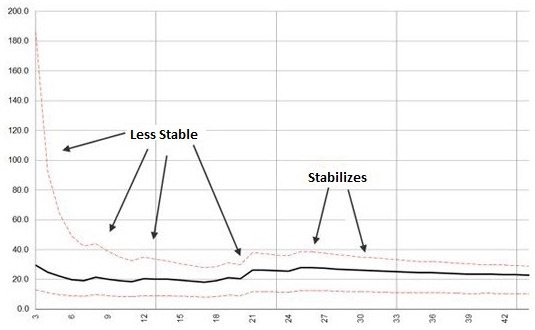
You probably noticed that this data series started to reach stability somewhere between 25 and 28 data points. And statisticians see this same phenomenon across a wide variety of data sets, leading to the rule of thumb of 30 data points needed.
Here's the Big Picture
For the sake of completeness, let's look at the standard deviation and upper/lower confidence limits charts for the other years in the election cycle. Here is the year that Hirsch found to be the worst, year 1 (post-election year):
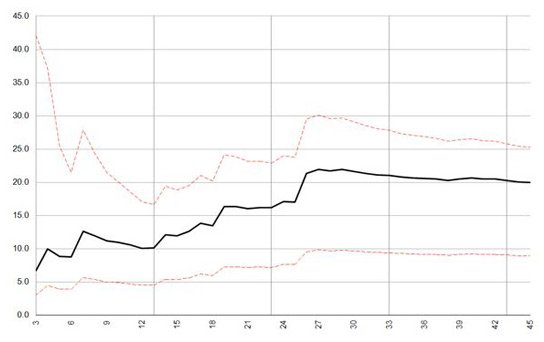
You can see that this first year is unstable for a longer period. This culminates in the big jump in standard deviation at data point 26 - when the market had a whopping 66.7% up year during 1933, Franklin Delano Roosevelt's first year in office.
What Is Alpha-9? Part supercomputer... part artificial intelligence... part sequence-matching protocol, Alpha-9 is the newest breakthrough from America's No. 1 Pattern Trader, Tom Gentile. And it could help make you a millionaire in just 12 months. Click here to learn more.
Compare this to the next chart, the second year of the cycle (dubbed the mid-term year):
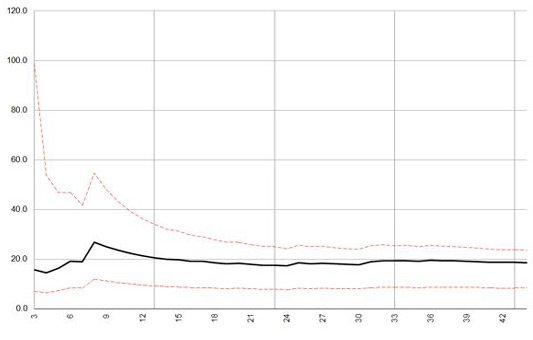
Here, we notice that the data set is much smoother, with fewer bumps and a quicker confluence of the confidence limits.
This is very important as we approach next year (2019), which will be this administration's third year of the cycle. It has been a consistently outperforming year across the breadth of this data.
Lastly, we have year four (election year):
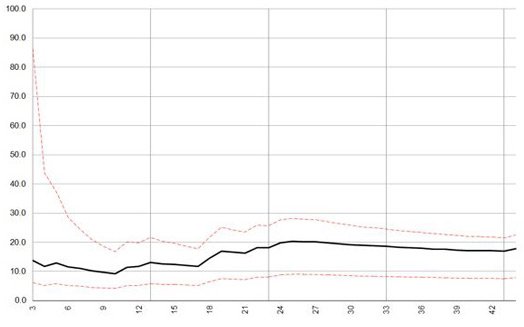
Nothing too exciting here, as we see the data stabilize less quickly than year two, but quicker than year one and about on par with year three. This leaves us with only one more graph to look at.
The presidential cycle debunker made a reasonably valid claim that Hirsch's pre-1900 stock data was suspect, since there were no standard indexes to draw from. Fair enough, but what if we look at only the post-1900 data? Does the data look like it is stabilizing? Does it pass the visual test?
"Federal Rent Checks": Thanks to an obscure law, over 100 government agencies are required to pay rent. By following a simple investment strategy, you could receive checks of up to $1,795 every month. Read more...
To check this, let's use the toughest test, the least stable data from year one:
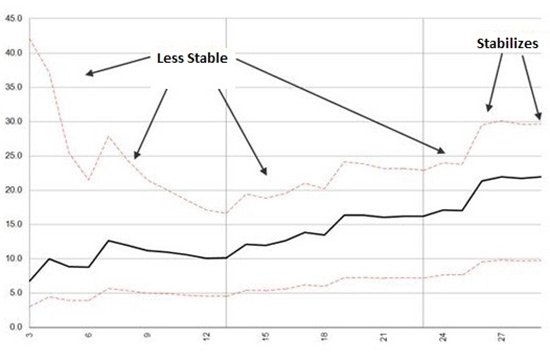
It certainly looks like the visual method confirms what the peer reviewed papers found - that there is in fact statistical validity to the smaller data set.
A Word of Caution
Remember that even validated seasonal patterns do not give us certainty. Rather, they give us an edge to push our expectation in a particular direction.
I hope that this unique visual way of looking at sample size implications has been as enlightening for you as it was for me!
In nearer-term market action, the next two days of trading will be very telling - especially the market's reaction to Friday's monthly employment data. That will be released an hour before markets open.
A break above or below the 2,600-2,815 S&P 500 range that we've been trapped in for almost two months will provide strong expectations for how markets close the year, and will guide our trading from here:
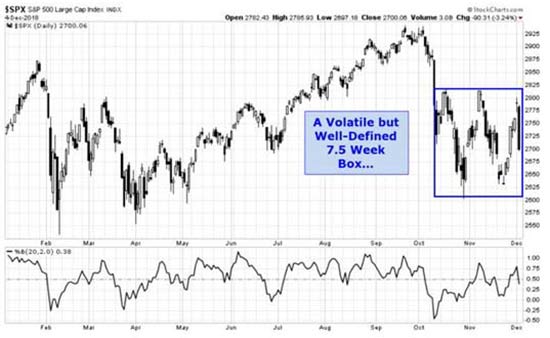
Starting Today, You Could Capture over $15,000 in Weekly Profits
We just unveiled a trading phenomenon that can deliver daily trade recommendations with unbeatable money-doubling potential.
We're talking $3,000, $4,000, even $5,000 per day.
You can make these simple plays in less than five minutes, straight from your phone or computer, from anywhere in the world.
And in a few minutes, you could change the course of your financial future forever.
Follow Money Morning on Facebook, Twitter, and LinkedIn.
About the Author
D.R. Barton, Jr., Technical Trading Specialist for Money Map Press, is a world-renowned authority on technical trading with 25 years of experience. He spent the first part of his career as a chemical engineer with DuPont. During this time, he researched and developed the trading secrets that led to his first successful research service. Thanks to the wealth he was able to create for himself and his followers, D.R. retired early to pursue his passion for investing and showing fellow investors how to build toward financial freedom.



